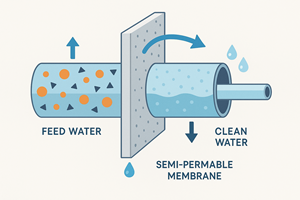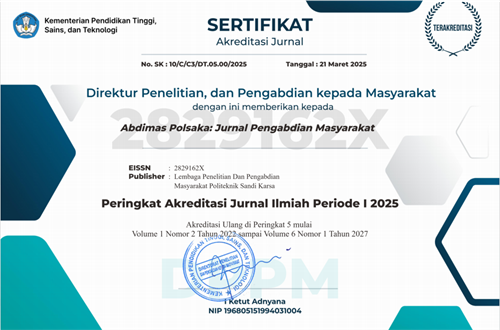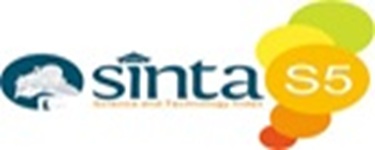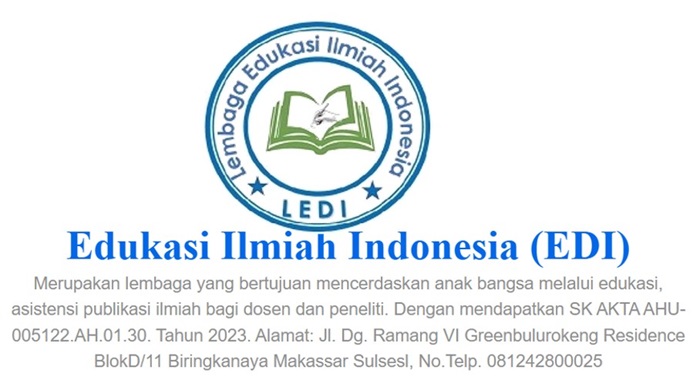Optimizing clean water filtration through the application of science and technology: Reverse osmosis method
DOI:
https://doi.org/10.35816/abdimaspolsaka.v4i2.112Keywords:
clean water, sosisalisasion, education, filtrasiAbstract
Water is the fundamental basis for all biological and human activities. Water is believed to be a natural resource that will never run out and will always be available at all times. Nonetheless, the availability of water as a natural resource is restrained due to its relatively constant hydrological cycle; thus making it limited in supply. The methods used during the activity were lectures and discussions. At the beginning of the activity, the team conducted counseling related to well water sanitation and its impact and how to overcome it. The method of this counseling stage is carried out through 5 stages, namely: socialization stage, implementation stage. This activity includes 3 sessions, among others: First stage: Pre test, which is given through a questionnaire, through lecture, question and answer, and discussion methods Post test and assessing the results of the post test, technology application stage, monitoring and evaluation stage, program sustainability stage. The results of the service activities showed that the educational program on access to clean water sanitation and the effects of borehole water for health succeeded in significantly increasing the knowledge of the participants. The average score increased from 19.22 in the pre-test to 21.18 in the post-test, with a p-value of 0.001 which shows a significant difference. This result confirms the effectiveness of the clean water sanitation education program.
Downloads
References
Y. Yuliati, A. A. F. Azis, I. Dharlis, S. A. Fachrin, and A. Baharuddin, “Edukasi Air Bersih Sumur Bor Dan Pemanfaatan Sereh Menjadi Spray Lation Anti Nyamuk DBD,” Martabe J. Pengabdi. Kpd. Masy., vol. 7, no. 9, pp. 3505–3510, 2024.
B. Rahayu and S. Darmawan, “Hubungan karakteristik balita, orang tua, higiene dan sanitasi lingkungan terhadap stunting pada balita,” Binawan Student J., vol. 1, no. 1, pp. 22–27, 2019.
A. Baharuddin, A. Junaid, and R. P. Poetra, “Edukasi Jamban Sebagai Upaya Pencegahan Stunting Berbasis Local Wisdom Pada Masyarakat Di Desa Tala-Tala,” Martabe J. Pengabdi. Kpd. Masy., vol. 6, no. 11, pp. 3880–3885, 2023.
R. M. Rahayu, E. P. Pamungkasari, and C. S. P. Wekadigunawan, “The biopsychosocial determinants of stunting and wasting in children aged 12-48 months,” J. Matern. Child Heal., vol. 3, no. 2, pp. 105–118, 2018.
A. Baharuddin, M. khidri Alwi, S. A. Maharani, A. A. Aulia, and N. F. Mubakkira, “Pemantauan dan Edukasi Sanitasi Kualitas air Sumur Bor pada Masyarakat di Dusun Paramppunganta Desa Kampili Kab Gowa,” Wind. Community Dedication J., pp. 63–70, 2024, doi: https://dx.doi.org/10.33096/wocd.v5i2.2298.
E. Andayanie, Y. Yuliati, and A. Baharuddin, “Perilaku Masyarakat Terhadap Pemanfaatan Akses Layanan Air Bersih Di Dusun Jenemadingi Kab Gowa,” Wind. Community Dedication J., pp. 55–62, 2024, doi: https://dx.doi.org/10.33096/wocd.v5i2.2299.
R. N. Yenita, M. Ramadhani, and E. Saputri, “Pengaruh Air Bersih dan Status Ekonomi Terhadap Kejadian Stunting di Wilayah Kerja Puskesmas Tapung Hilir II,” J. homepage http//journal. pasca-unri. org/index. php/econews, vol. 4, no. 2, pp. 66–68, 2021.
S. A. A. Sofyan, “Optimasi Operasi Waduk Jatigede Menggunakan Linear Programming dan Chance Contsraint Non Linear Programming,” J. Appl. Civ. Environ. Eng., vol. 1, no. 2, pp. 51–60, 2021.
I. Hasanah and H. Susanti, “Does water and sanitation effects on children’s physical development? Evidence from Indonesia Family life Survey (IFLS) 2014,” in E3S Web of Conferences, 2018, vol. 74, p. 9007, doi: https://dx.doi.org/10.1051/e3sconf/20187409007.
W. Angraini, M. Amin, B. A. Pratiwi, H. Febriawati, and R. Yanuarti, “Pengetahuan ibu, akses air bersih dan diare dengan stunting di puskesmas aturan Mumpo Bengkulu Tengah,” J. Kesmas (Kesehatan Masyarakat) Khatulistiwa, vol. 8, no. 2, p. 92, 2021, doi: https://dx.doi.org/10.29406/jkmk.v8i2.2816.
A. Nagar and T. Pradeep, “Clean water through nanotechnology: needs, gaps, and fulfillment,” ACS Nano, vol. 14, no. 6, pp. 6420–6435, 2020, doi: https://dx.doi.org/10.1021/acsnano.9b01730.
M. A. Alkhadra et al., “Electrochemical methods for water purification, ion separations, and energy conversion,” Chem. Rev., vol. 122, no. 16, pp. 13547–13635, 2022, doi: https://dx.doi.org/10.1021/acs.chemrev.1c00396.
S. Suprapto and D. Arda, “Pemberdayaan Masyarakat Melalui Penyuluhan Perilaku Hidup Bersih dan Sehat Meningkatkan Derajat Kesehatan Masyarakat,” J. Pengabdi. Kesehat. Komunitas, vol. 1, no. 2, pp. 77–87, Aug. 2021, doi: https://doi.org/10.25311/jpkk.Vol1.Iss2.957.
A. Toalu, “Edukasi Pengetahuan KIA dan Kesehatan Lingkungan Dalam Upaya Peningkatan Derajat Kesehatan Pada Masyarakat,” Abdimas Polsaka J. Pengabdi. Masy., vol. 2, no. 1, pp. 70–75, 2023.
C. Cheng, F. Zhang, J. Shi, and H.-T. Kung, “What is the relationship between land use and surface water quality? A review and prospects from remote sensing perspective,” Environ. Sci. Pollut. Res., vol. 29, no. 38, pp. 56887–56907, 2022, doi: https://dx.doi.org/10.1007/s11356-022-21348-x.
C.-J. Chen, Y.-C. Chen, M.-Y. Lee, C.-H. Wang, and H.-C. Sung, “Effects of three-dimensional holograms on the academic performance of nursing students in a health assessment and practice course: A pretest-intervention-posttest study,” Nurse Educ. Today, vol. 106, p. 105081, 2021, doi: https://dx.doi.org/10.1016/j.nedt.2021.105081.
J. S. Kim, J. H. Choi, and M. S. Kwon, “Developing and evaluating an educational program for respiratory infection prevention among rural elderly residents in South Korea,” Int. J. Environ. Res. Public Health, vol. 17, no. 9, p. 3057, 2020, doi: https://dx.doi.org/10.3390/ijerph17093057.
S. Assadi Hoveyzian, A. Shariati, S. Haghighi, S. M. Latifi, and M. Ayoubi, “The effect of portfolio-based education and evaluation on clinical competence of nursing students: A pretest–posttest quasiexperimental crossover study,” Adv. Med. Educ. Pract., pp. 175–182, 2021, doi: https://dx.doi.org/10.2147/AMEP.S231760.

Additional Files
Published
How to Cite
Issue
Section
License
Copyright (c) 2025 Yuliati Yuliati, Alfina Baharuddin, Hardi Hardi, Siti Astachya Ananda Sofyan, Suharni A. Fachrin, Ella Andayanie

This work is licensed under a Creative Commons Attribution 4.0 International License.
Most read articles by the same author(s)
- Suharni A.Fachrin, Alfina Baharuddin, Fatma Jama, Hukma Ratu Purnama, Yuliati Yuliati, Ella Andayanie, Personal protective equipment as a measure to limit disability among ironworkers in maros regency , Abdimas Polsaka: Vol. 4 No. 2 (2025): Abdimas Polsaka: Jurnal Pengabdian Masyarakat
- Ella Andayanie, Alfina Baharuddin, Asmarani Harma, Annisa Junaid, Yuliati Yuliati, Suharni A. Fachrin, Clean Water Self-Sufficiency and Well Water Filtration Method Education for Health Workers in Gowa Regency , Abdimas Polsaka: Vol. 4 No. 2 (2025): Abdimas Polsaka: Jurnal Pengabdian Masyarakat




















